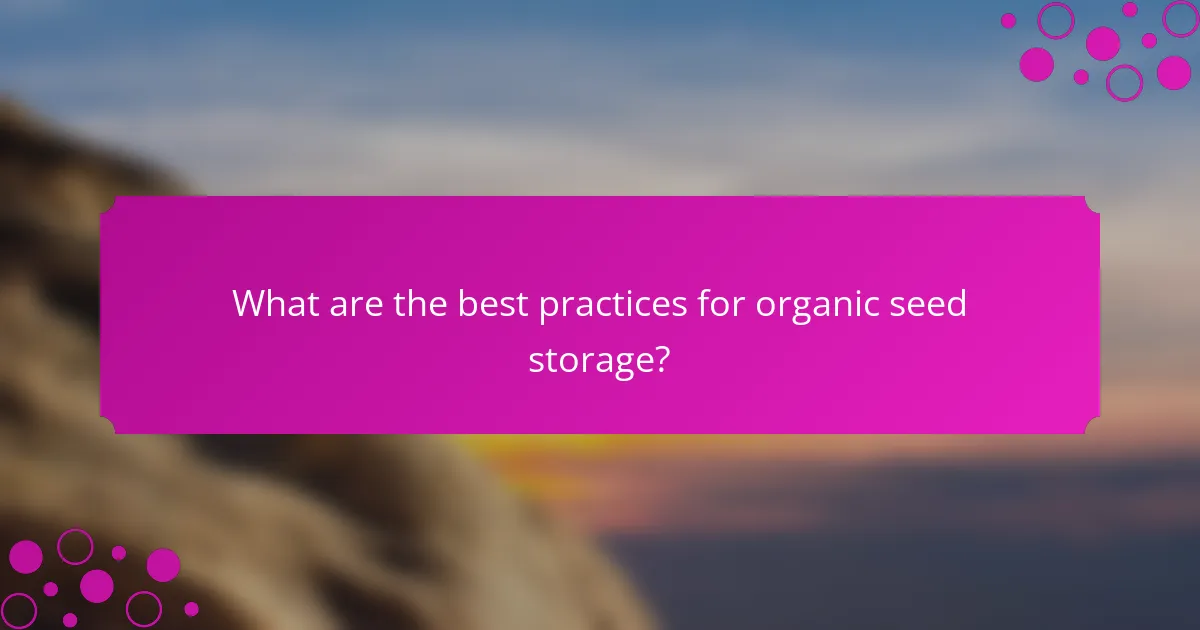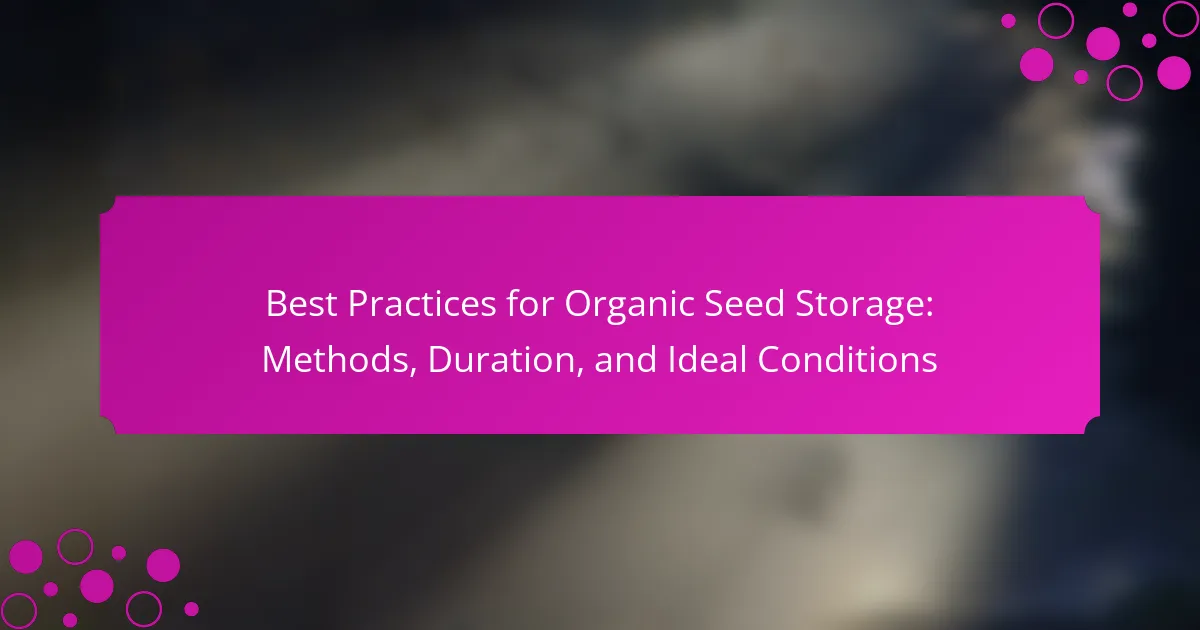Organic seed storage involves specific practices to ensure seed viability and longevity. Key methods include maintaining low humidity levels, cool temperatures between 32°F to 41°F (0°C to 5°C), and protecting seeds from light exposure. Seeds should be stored in airtight containers to prevent moisture absorption, with a relative humidity of 20% or lower being ideal. Proper labeling of containers with seed type and harvest date is crucial for identification, while regular checks for mold or pests are necessary to maintain quality. Adhering to these best practices can significantly extend the storage life of seeds and improve germination rates.

What are the best practices for organic seed storage?
The best practices for organic seed storage include maintaining low humidity, cool temperatures, and protecting seeds from light. Seeds should be stored in airtight containers to prevent moisture absorption. Ideal storage temperatures range from 32°F to 41°F (0°C to 5°C). A relative humidity level of 20% or lower helps preserve seed viability. Labeling containers with the seed type and harvest date ensures proper identification. Regularly checking seeds for signs of mold or pests is essential for maintaining quality. Following these practices can extend the storage life of seeds for several years. Research indicates that proper storage conditions can improve germination rates significantly.
How do different methods of seed storage impact viability?
Different methods of seed storage significantly impact seed viability. For instance, seeds stored in cool, dry conditions maintain higher viability than those kept in warm, humid environments. Research indicates that seeds stored at temperatures below 10°C can retain viability for several years. Conversely, seeds exposed to moisture can germinate prematurely or develop mold, reducing their lifespan. Additionally, vacuum sealing seeds can limit exposure to air and moisture, preserving viability. A study by the USDA found that properly stored seeds can maintain over 80% viability for decades. Thus, the method of storage directly influences the longevity and germination potential of seeds.
What are the most effective containers for organic seed storage?
The most effective containers for organic seed storage are airtight glass jars, metal tins, and vacuum-sealed bags. Airtight glass jars prevent moisture and pests from damaging seeds. They also allow for visibility and easy access. Metal tins offer durability and protection from light and moisture. Vacuum-sealed bags reduce air exposure, extending seed viability. Research indicates that proper storage conditions can maintain seed germination rates for years. The USDA recommends using these containers to maximize seed longevity.
How does moisture control affect seed longevity?
Moisture control significantly affects seed longevity. Proper moisture levels prevent seed deterioration and maintain viability. High moisture can lead to mold growth and seed decay. Conversely, too low moisture may cause seeds to dry out and lose germination potential. Research indicates that seeds stored at 5-7% moisture content have optimal longevity. A study by the USDA shows that seeds stored in low humidity conditions can last several years longer than those in high humidity. Thus, maintaining appropriate moisture levels is crucial for preserving seed viability over time.
What is the ideal duration for storing organic seeds?
The ideal duration for storing organic seeds is typically 1 to 3 years. Most organic seeds retain their viability for this period when stored properly. Factors affecting seed longevity include moisture, temperature, and light exposure. For best results, seeds should be kept in a cool, dark, and dry environment. Research shows that seeds stored in airtight containers can last longer. Additionally, certain seeds may have longer shelf lives, such as beans and peas, which can last up to 5 years. Proper storage conditions significantly enhance seed longevity and germination rates.
How do different seed types vary in storage duration?
Different seed types vary significantly in storage duration. For example, vegetable seeds like carrots and lettuce can typically be stored for 1 to 3 years. In contrast, tomato seeds may last up to 5 years under proper conditions. Grains such as wheat and corn can remain viable for 10 years or more if kept dry and cool. Legume seeds, like beans, usually have a storage duration of about 3 to 5 years. Factors influencing these durations include moisture content, temperature, and seed type. Studies show that seeds stored in cool, dark, and dry environments maintain viability longer. Thus, understanding these variations is crucial for effective seed storage practices.
What signs indicate seeds are reaching the end of their storage life?
Seeds reaching the end of their storage life exhibit several signs. First, a decrease in germination rates is a primary indicator. Testing seeds can show reduced viability over time. Second, changes in seed appearance may occur. Seeds might become discolored or develop mold. Third, physical changes like shriveling or brittleness can indicate aging. Lastly, an off smell can suggest spoilage. These signs collectively suggest that seeds may no longer be suitable for planting.
What conditions are necessary for optimal seed storage?
Optimal seed storage requires specific conditions to maintain seed viability. The ideal temperature for seed storage is typically between 32°F and 41°F (0°C to 5°C). Humidity levels should be kept low, ideally below 20%. Seeds should be stored in airtight containers to prevent moisture ingress. Dark environments are preferred to avoid light exposure, which can degrade seed quality. Regular monitoring of seed condition is essential to detect any signs of deterioration. These conditions help preserve the seeds’ genetic integrity and germination potential over time.
How does temperature influence seed viability?
Temperature significantly influences seed viability. Optimal temperatures promote germination and seed health. High temperatures can lead to seed degradation. Low temperatures may slow down metabolic processes. Each seed type has a specific temperature range for viability. For instance, many seeds thrive between 20°C to 25°C. Research shows that temperatures above 30°C can reduce germination rates significantly. Additionally, prolonged exposure to extreme temperatures can shorten seed lifespan. Proper temperature management is essential for effective seed storage.
What role does light play in the storage of organic seeds?
Light plays a significant role in the storage of organic seeds. Exposure to light can trigger germination processes in seeds. This can lead to reduced viability and overall seed quality. Seeds stored in dark conditions maintain their dormancy longer. Research indicates that light-sensitive seeds are particularly affected by light exposure. For example, seeds like lettuce and spinach require darkness for optimal storage. Proper storage conditions should limit light exposure to preserve seed integrity. Maintaining a dark environment is essential for extending the lifespan of organic seeds.
How can I transition from general practices to specific techniques?
To transition from general practices to specific techniques in organic seed storage, start by identifying key methods relevant to your context. Focus on specific storage conditions such as temperature, humidity, and light exposure. Research best practices for each seed type, as requirements can vary significantly. Implement techniques like using airtight containers or vacuum sealing for optimal preservation. Monitor seed viability through regular germination tests to ensure effectiveness. Document your processes to refine techniques over time. Specific methods, such as cold storage for certain seeds, have been shown to extend shelf life significantly. Following these targeted approaches will enhance your seed storage practices.
What are the common challenges in organic seed storage?
Common challenges in organic seed storage include moisture control, pest infestation, and temperature fluctuations. Moisture can lead to mold and seed degradation. Pest infestation can damage seeds and reduce viability. Temperature fluctuations can affect seed longevity and germination rates. Additionally, improper storage containers may not provide adequate protection. These factors can significantly impact the quality and viability of stored organic seeds.
What specific techniques enhance organic seed storage?
Proper techniques for enhancing organic seed storage include maintaining optimal moisture levels, ensuring cool temperatures, and utilizing airtight containers. Moisture levels should ideally be below 10% to prevent mold growth. Cool temperatures, typically between 32°F and 41°F, help preserve seed viability. Airtight containers, such as glass jars or vacuum-sealed bags, protect seeds from pests and humidity. Additionally, labeling seeds with harvest dates and variety ensures better tracking of seed viability over time. Research shows that these techniques can significantly extend the shelf life of seeds, preserving their germination rates for years.
How can I properly label and organize my seed collection?
To properly label and organize your seed collection, start by using clearly labeled envelopes or containers for each seed type. Include essential information such as the plant name, variety, and date of collection on each label. Organize the seeds by categories like vegetable, herb, and flower for easier access. Use a spreadsheet or inventory list to track your collection, noting the location of each seed type. Ensure that the labels are waterproof and durable to withstand moisture. Store the organized seeds in a cool, dark place to maintain viability. Research shows that proper labeling and organization can significantly improve seed storage efficiency and accessibility.
What are the best practices for monitoring seed condition over time?
Regularly inspect seeds for signs of deterioration. Check for mold, discoloration, and insect damage. Maintain records of seed condition over time. Use a consistent schedule for monitoring, such as monthly checks. Store seeds in a controlled environment with stable temperature and humidity. Use airtight containers to minimize exposure to moisture and pests. Conduct germination tests periodically to assess viability. Proper documentation of observations helps track changes and inform storage practices.
What troubleshooting tips can help with organic seed storage?
Store organic seeds in a cool, dry place to prevent moisture damage. Use airtight containers to minimize exposure to humidity. Label containers with the seed type and date of storage for easy identification. Check seeds periodically for signs of mold or pests. Maintain a consistent temperature to avoid fluctuations that can affect seed viability. If seeds are not germinating, test a small sample to assess their viability. Discard any seeds that show signs of decay or damage. Proper storage conditions can extend the shelf life of organic seeds significantly, with some seeds lasting several years when stored correctly.
The main entity of the article is organic seed storage, which encompasses best practices, methods, duration, and ideal conditions for preserving seed viability. Key information includes maintaining low humidity levels below 20%, storing seeds in cool temperatures between 32°F and 41°F, and using airtight containers to prevent moisture and pest damage. The article also discusses the impact of different storage methods on seed longevity, identifies effective containers, and outlines specific techniques for monitoring seed condition over time. Understanding these practices is essential for maximizing the shelf life and germination potential of organic seeds.
